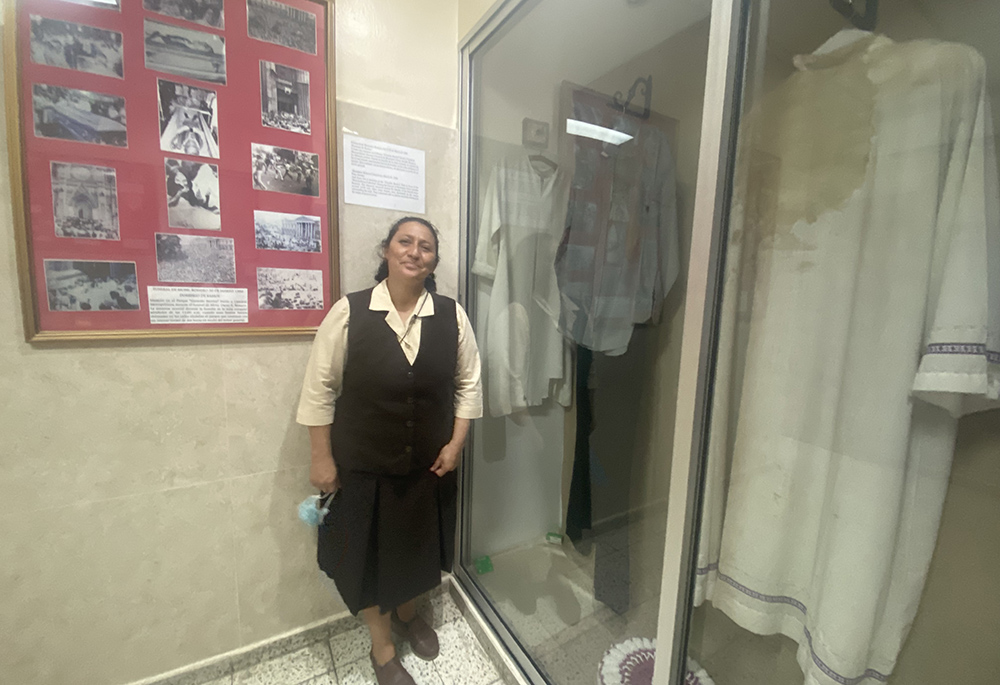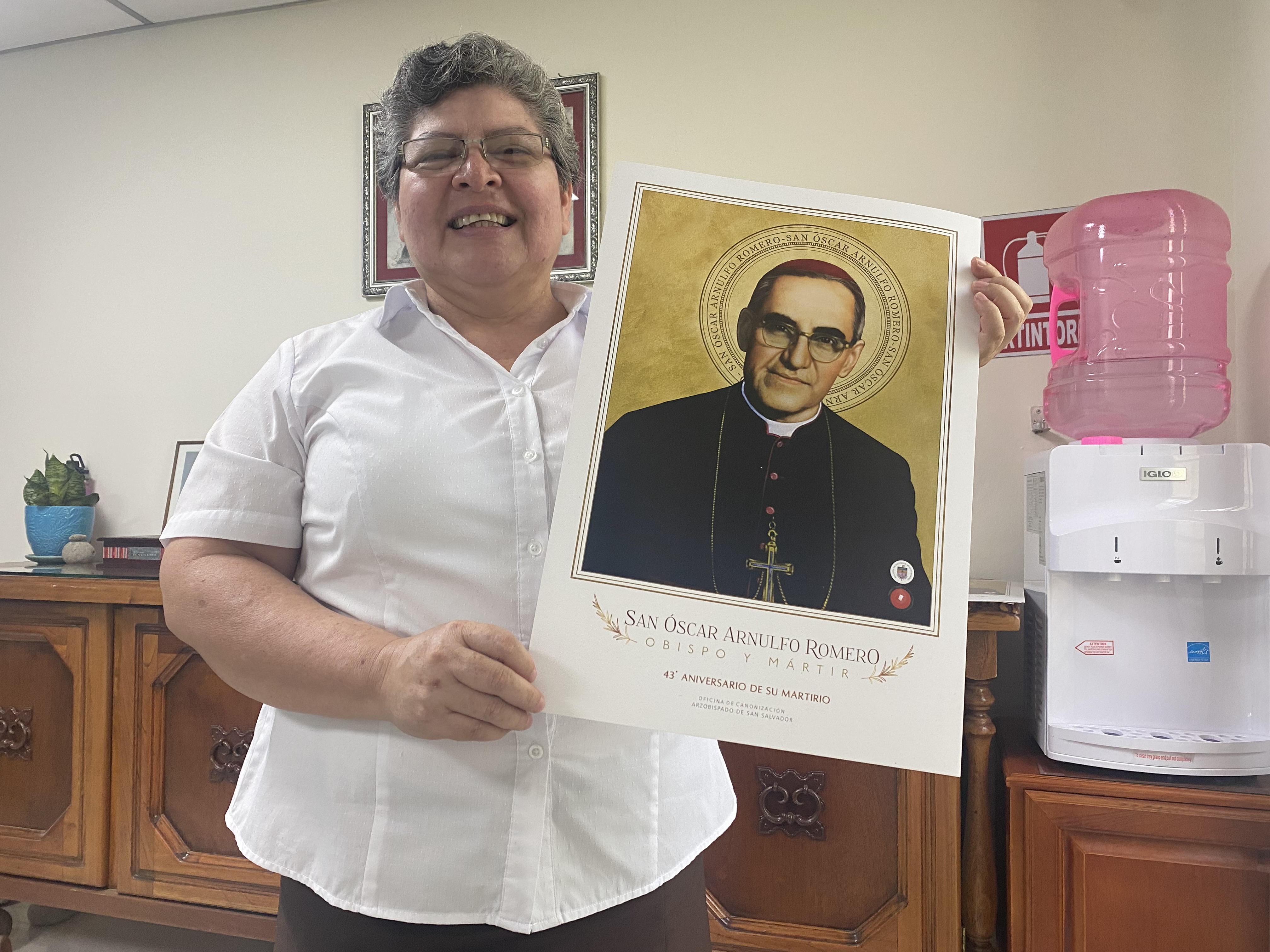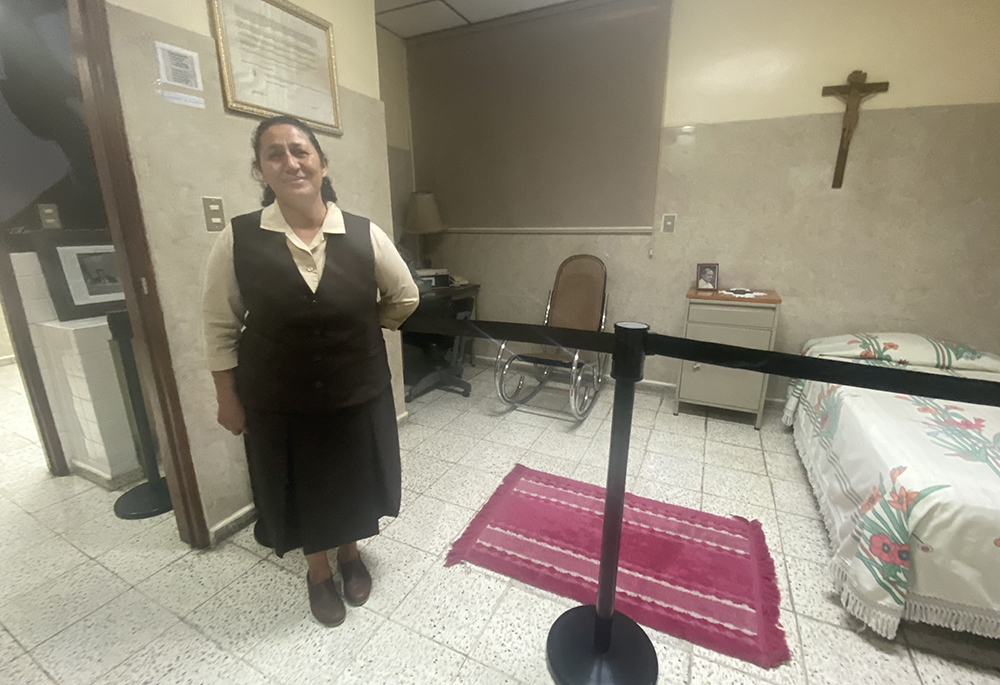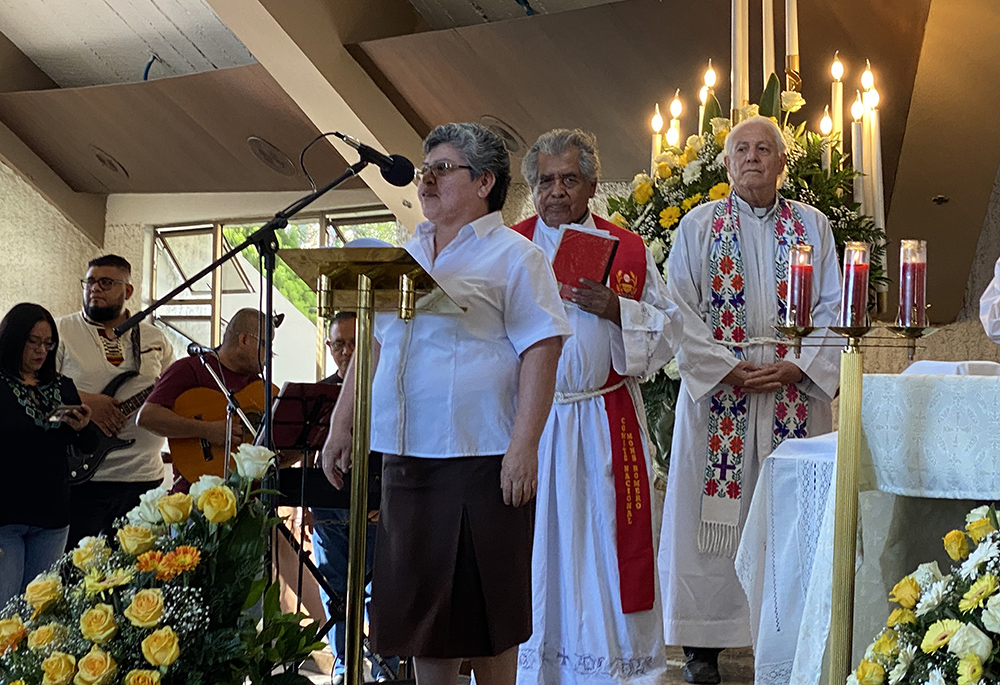
Sr. Ruby Lemus Salguero stands next to a case that holds the bloodstained relics of St. Oscar Romero March 24, on the grounds of the Divine Providence Hospital in San Salvador, El Salvador. Among the relics is the habit of a nun, one of the Missionary Carmelites of St. Teresa, who ran to Romero's side after he was fatally shot and whose dress absorbed some of the martyr’s blood. (GSR photo/Rhina Guidos)
In the small house where St. Óscar Romero lived when he was the archbishop of San Salvador, the white habit of a religious sister can be seen to the left of the bloodied relics of the Salvadoran martyr.
"I asked, 'And what's that doing there?' " said Sr. Tránsito de la Cruz Valdez Crespín, recalling the first time she saw the habit.
The habit goes almost unnoticed, as it is next to what Romero was wearing on the day of his martyrdom: a shirt covered in blood, a remnant caused by the bullet that passed through his body while he was celebrating Mass. A closer look at the simple garment of the nun reveals a series of stains on the seam of the skirt, adding to the story of what transpired that day.
The stains mark part of the history of the martyrdom of March 24, 1980, and of the fidelity of the Missionary Carmelites of St. Teresa with St. Romero, the community of which Mother Valdez is now superior. While many hid in the pews when they heard the bullet, two sisters made their way to the altar, recalled the mother superior. They kneeled on the floor of the chapel of the Divine Providence Hospital, where Romero collapsed.
Today, as then, the community runs the hospital alongside the chapel and offers help to low-income patients suffering from cancer. Romero had known the community for a long time before he decided to live among the sisters and the poor patients when he was named archbishop in 1977.

Sr. Tránsito de la Cruz Valdez Crespín holds a poster of St. Oscar Romero March 24, in her office close to the chapel where he was martyred. Valdez is the superior of the Missionary Carmelites of St. Teresa, who care for the house the Salvadoran saint lived in on the grounds of the hospital for poor cancer patients that the religious community still operates. (GSR photo/Rhina Guidos)
At Romero's side at the time of his martyrdom — when he was shedding blood from his nose and mouth — two Carmelite sisters, alongside another woman and a man, tried in vain to save the life of the saint, something captured in historic photos of that day. That's how the nun's habit absorbed the blood of the martyr.
Valdez remembers what the sisters who were in the chapel that night revealed to her many years later: They were at Mass. Then, before the consecration, they saw a flash of light, probably caused by the bullet, and then there was a loud sound. Then, Romero fell to the floor, they told her.
The sisters keep the memory of the martyr alive in the hospital grounds in what they consider the saint's "shrine": a small residence they built for him at the entrance to the property. It was a gift to celebrate Romero's 60th birthday in 1977, close to the chapel where he died.
Although many refer to the house as the "museum" of the saint, "We, the Carmelite Missionaries, insist on calling it a shrine," said Sr. Ruby Lemus Salguero, who guides visiting pilgrims.
Officially, the Holy See, in the Code of Canon Law, states that the designation "shrine" is given to a church or other sacred place to which "numerous members of the faithful make pilgrimage for a special reason of piety" and must be approved by the local bishop or by the bishops' conference for its official designation as a national shrine.
But the sisters refer to it as such because of the popularity of the site to devotees of St. Romero. Lemus said that people from all over the world visit it, from places like Germany, England and all the countries in Latin America. They also come from countries on the other side of the world, like Madagascar and India.

Sr. Ruby Lemus Salguero stands in front of a room where St. Oscar Romero lived and worked, as pilgrims visited the house March 24, on the grounds of the Divine Providence Hospital in San Salvador, El Salvador. Missionary Carmelites of St. Teresa care for the house where he lived on the grounds of the hospital for poor cancer patients that the religious community still operates. (GSR photo/Rhina Guidos)
"St. Romero is known for his testimony of commitment, of faith . . . where there is poverty, the voice of Romero continues to illuminate, inviting us to maintain hope," Lemus said.
Valdez also believes that the example of Romero, his message of peace and defense of human rights transcends religious beliefs.
"People from different religious denominations visit. Hindus, Buddhists," she said.
However, caring for the memory of the saint has not been an easy task for the community.
Long before he was recognized as a saint, there was a period when Romero was considered a "bad word," as Pope Francis told Central American bishops in 2019. The sisters — whose house is next door to the chapel and on the other side of the house where the saint lived — suffered humiliation and slander. On some occasions they also risked safety for wanting to protect his belongings, which they considered relics from early on.
Some upper-class benefactors who had economically helped the sisters with the hospital, believing the slander some said about Romero — that he was subversive, dangerous, a guerrilla — turned their backs on them. Some cut off their financial support, the mother superior recalled.
"The sisters did not care because we knew that [divine] providence was going to move the hearts of people," she said.
Advertisement
Valdez said the house also was a "target of police raids and extraction of objects" on many occasions.
During the civil war in El Salvador — when Valdez lived in the community of the hospital compound as a novice and later as a junior — she remembers soldiers walked in, dividing the sisters into groups, and ordered access to everything.
Valdez has memories of that horrific time, answering the phone and receiving calls accusing the sisters of being part of the guerilla, the rebel group, saying, "We are going to kill you. A bomb will destroy you," accusing them of using their sick patients to hide their real motives.
Soldiers regularly came to remove objects from Romero's house and sometimes prevented the sisters from entering the property.
"We couldn't even enter, or see what they took, what they didn't take. What is currently there is what has survived," Valdez said.
But it is enough to tell the story.
The small house has a simple room where Romero lived. In it, there is a small bed, a desk, his typewriter and a tape recorder the saint used to record his journal entries; there is also a photo of his friend, Pope Paul VI, who was canonized alongside Romero in 2018, and a rocking chair. His handkerchiefs with initials embroidered by the sisters are still in the room, as well as a small collection of books near the entrance of the house.

Pope Francis passes banners of newly canonized saints during his general audience in St. Peter's Square Oct. 17, 2018, at the Vatican. The banners show Sts. Vincenzo Romano, Oscar Romero and Paul VI. (CNS/Paul Haring)
Among the most moving relics, the saint's cincture — the cord priests use to gird their alb — stained by the blood that flowed from his body. The sisters let Pope Francis borrow it, and he wore it for the Salvadoran saint's canonization ceremony in 2018.
But the place also has mundane things: passports, Romero's driver's license, his agenda, notes, business cards, a shaving kit, things that give the space a feeling of a home.
The stories of the sisters who lived with him also help fuel the imagination of what it was like to live with a contemporary saint.
Valdez said that these days everyone thinks of a Romero "with a halo" but the sisters remember a Romero with a strong personality and one who would not accept gifts easily, unless they came from the poor.
Knowing that he would not accept from the sisters a house they built for him — so that he would stop living in a tiny room next to the sacristy in the chapel — they looked for another way to make him accept.
"He took time to visit the patients; he always did that," Valdez said.
The sisters told the patients to give him the key to the house "because he is not going to say no to you," they told the patients.
And that is how the archbishop ended up living on the property where his car still stands and where you can imagine the saint lying in a hammock that the sisters say he used to use.

Sr. Tránsito de la Cruz Valdez Crespín welcomes pilgrims gathered March 24, at the Divine Providence Hospital chapel, where St. Oscar Romero was martyred. Valdez, superior of the Missionary Carmelites of St. Teresa, who care for the house where the Salvadoran saint lived, a short distance from the chapel, spoke about Romero's closeness to the religious community that tends to poor cancer patients. (GSR photo/Rhina Guidos)
"He is a person who is still so alive, so present, so current," Valdez said, adding: "And the sisters [who lived around him] have also played a very important role in this by transmitting the anecdotes to us."
Taking care of the saint's house and serving pilgrims is so important to the sisters that it is part of the community's daily activities, Valdez said.
"The congregation has assigned a sister precisely for this," she said, and it's considered a ministry within the community.
Last year, Lemus wrote to Pope Francis, telling him about the work of the congregation to care for the saint's house.
"Around this time last year, the pope responded with a beautiful letter in which he encouraged us to continue protecting the memory of St. Romero. For us, that is invaluable," Valdez said.
She said that what she wants most from the people who visit the place they consider holy is for them to get to know Romero better. "We [must] not be spectators. [Romero] taught us to be more than spectators. He could have limited himself to listening, caring for people, and stop there," she said.
But Romero got into the depths of the injustices and abuses of a suffering population. That's where he had the experience of encounter that transformed him into a saint, the mother superior added.
"This encounter transforms us," Valdez said. "Let it be an experience of encounter here: Let's call it faith, let's call it a life change, but in such a way that it transforms our behavior.”
She would also like more people to collaborate with the sisters to keep the martyr's house in good condition.
"I really admire people who come in and say, 'What can we do to preserve it? What is needed to take care of it, to keep it clean, dignified, to preserve it?' Very few people are interested, and they are from abroad, curiously," Valdez said.
Some people, as they arrive to visit the places where Romero lived, also take notice of the poor who go to the hospital, and in his honor, some leave a donation, Valdez said, proof that the saint continues working for the poor from the heavens.
"They tell us: 'Look, I met Msgr. Romero or learned about [the hospital] through Msgr. Romero and here I bring a collaboration for the hospital, because I found out about it through him,'" Valdez said, adding: "So I say, [St. Romero] continues to support this work."








